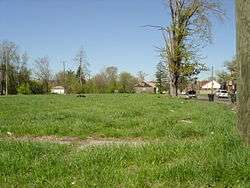Urban prairie

Urban prairie is a term to describe vacant urban land that has reverted to green space. Previous structures occupying the urban lots have been demolished, leaving patchy areas of green space that are usually untended and unmanaged. Sometimes, however, the prairie spaces are intentionally created to facilitate amenities such as community gardens and wildlife habitats.[1]
Urban prairies can result from several factors. The value of aging buildings may fall too low to provide financial incentives for their owners to maintain them. Vacant properties may have resulted from deurbanization or crime, or may have been seized by local government as a response to unpaid property taxes. Since vacant structures can pose health and safety threats (such as fire hazards), or be used as a location for criminal activity, cities often demolish them.

Sometimes areas are cleared of buildings as part of a revitalization plan with the intention of redeveloping the land. In flood-prone areas, government agencies may purchase developed lots and then demolish the structures to improve drainage during floods. Some neighborhoods near major industrial or environmental clean-up sites are acquired and leveled to create a buffer zone and minimize the risks associated with pollution or industrial accidents. Such areas may become nothing more than fields of overgrown vegetation, which then provide habitat for wildlife. Sometimes it is possible for residents of the city to fill up the unplanned empty space with urban parks or community gardens.[2]
Urban prairie is sometimes planned by the government or non-profit groups for community gardens and conservation, to restore or reintroduce a wildlife habitat, help the environment, and educate people about the prairie.[3]
References
- ↑ Graybill, Jessica K. "Rust-to-Resilience: Local Responses to Urban Vulnerabilities in Utica, New York." In Dooling, Sarah & Simon, Greg, eds. (2012). Cities, Nature and Development: The Policies and Production of Urban Vulnerabilities, p. 176. Ashgate Publishing Limited.
- ↑ Gallagher, John (2010). Reimagining Detroit: Opportunities for Redefining an American City, p. 24. Wayne State University Press.
- ↑ Missouri Conservation News
External links
![]() Media related to Urban prairie at Wikimedia Commons
Media related to Urban prairie at Wikimedia Commons